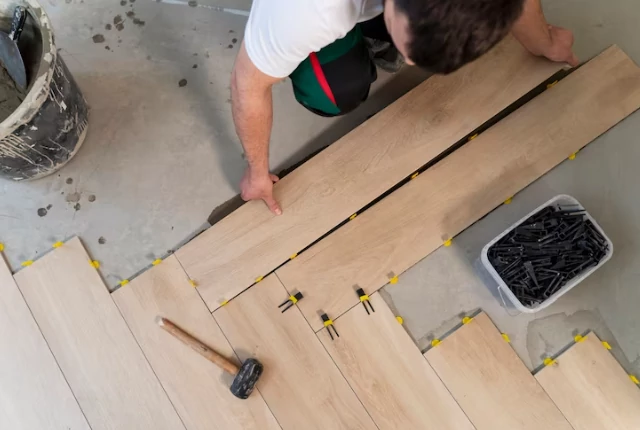Flooring is an essential part of any property, whether it be a residential or commercial space. It provides a foundation for furniture and other fixtures, as well as enhancing the aesthetic appeal of the room. However, over time flooring can become dull and worn out due to constant foot traffic, spills, scratches, and other forms of wear and tear.
This is where floor restoration comes in; restoring your floors can breathe life back into them and give your space a fresh new look. If you are considering floor restoration but do not know where to start, this guide will provide you with valuable information on how to bring back the beauty of your floors.
From identifying the type of flooring to selecting the right products and tools for each specific material, this guide will cover everything you need to know about floor restoration. By following our step-by-step process, you can turn your old floors into beautiful masterpieces that will enhance the overall look and feel of your property.
Identify the Type of Flooring
The identification of the type of flooring is a crucial step in any floor restoration project, as it determines the appropriate cleaning and restoration methods needed to bring back its original beauty.
There are many types of flooring, including hardwood, laminate, vinyl, tile, and carpet. Each type requires specific care and attention to bring out its natural beauty.
For example, hardwood floors need to be sanded down and refinished periodically to remove scratches and restore their shine. Laminate and vinyl floors can be cleaned with mild soap and water but should not be wet-mopped or exposed to excessive moisture.
Tile floors require regular grout cleaning and sealing to prevent staining, while carpets need to be vacuumed regularly and deep-cleaned periodically by a professional cleaner.
By identifying the type of flooring in your home or business, you can ensure that it receives the proper care it needs for long-term durability and aesthetics.
Select the Right Products and Tools
To achieve a successful flooring restoration project, it is crucial to select the right products and tools for the job.
This includes carefully choosing appropriate cleaning and repair products that are compatible with the flooring material.
Investing in high-quality refinishing products is also essential to ensure long-lasting results.
Moreover, using the right tools and equipment can significantly impact the outcome of the restoration process, making it more efficient and effective.
Choose the Appropriate Cleaning and Repair Products
Selecting suitable cleaning and repair products is crucial to ensure the longevity of your floor. Studies show that using improper chemicals can reduce its lifespan by up to 50%. Therefore, it is important to choose the appropriate cleaning and repair products for your particular type of flooring material.
For example, if you have hardwood floors, you should avoid using acidic or alkaline cleaners as they can damage the finish and cause discoloration. Instead, opt for pH-neutral cleaners specifically designed for hardwood floors.
When it comes to repairing your floors, it’s essential to use products that are compatible with the materials used in their construction. For instance, if you have ceramic tiles, ensure that the adhesive used for repairs matches the existing grout color.
If you’re unsure about which product is best suited for your floor type or damage level, consult a professional restoration service provider who can guide you through the process.
In summary, selecting appropriate cleaning and repair products not only safeguards your floor’s longevity but also enhances its beauty while preventing costly replacements or repairs in future years.
Invest in High-Quality Refinishing Products
Investing in high-quality refinishing products is essential for maintaining the durability and appearance of your flooring materials. These products are specifically designed to restore and protect the natural beauty of your floors, while also providing a layer of protection against damage from foot traffic, spills, and other forms of wear and tear.
High-quality refinishing products are typically made from top-grade ingredients that provide superior results compared to lower quality alternatives. When selecting refinishing products, it’s important to consider the type of flooring material you have as well as any specific needs or concerns you may have.
For example, some products may be better suited for hardwood floors, while others may work best for tile or concrete surfaces. Additionally, you should consider factors such as ease of application, drying time, and overall durability when making your selection.
By investing in high-quality refinishing products that are tailored to your specific needs, you can help ensure that your floors will look beautiful and remain protected for years to come.
Use the Right Tools and Equipment for the Job
Using appropriate tools and equipment is crucial in ensuring a successful refinishing process and achieving optimal results for your flooring. Here are three essential items you will need to have on hand:
1. Sandpaper – This abrasive material is used to remove any old finishes, stains, or scratches on the floor’s surface before applying new ones. The grit level of the sandpaper will depend on the condition of your floor; however, it is advisable to start with a lower grit level and work your way up.
2. Floor buffer – A floor buffer is an electric machine that polishes the surface of your floor after sanding, providing a smooth and even finish. It has different pads available depending on what type of finish you want to achieve.
3. Vacuum cleaner – After sanding and buffing, it’s imperative to get rid of all dust particles left on the surface before applying any new finishes or stains. A vacuum cleaner with a hose attachment can be used for this purpose efficiently.
Investing in high-quality tools and equipment not only ensures optimal results but also saves time and resources in the long run by avoiding costly mistakes during the refinishing process. By using these three items correctly, you can breathe life back into your flooring, transforming it from dull to beautiful again.
Follow the Restoration Process
The restoration process for floors involves several steps that are crucial to achieving a successful outcome. The first step is to assess the condition of the floor, identify any damages, and determine the best course of action.
This may include repairing or replacing damaged sections, cleaning and sanding the surface, and applying a sealer or finish.
Once the necessary repairs have been made and the surface has been prepared, it’s time to apply the chosen finish. This may involve using a stain to add color to wood floors or applying a protective coating to seal in newly refinished concrete floors.
It’s important to follow manufacturer instructions carefully when applying finishes and allow ample drying time before walking on or placing furniture on newly restored floors.
By following these steps carefully and using quality materials, you can bring back the beauty of your floors for years to come.
Frequently Asked Questions
How much does floor restoration typically cost?
The cost of floor restoration depends on several factors, such as the type of flooring material, the level of damage or wear, and the size of the area to be restored. Generally, prices can range from $3 to $10 per square foot for basic refinishing services. However, more complex restoration projects may cost significantly more.
Can all types of flooring be restored, or are some too damaged?
Floor restoration is feasible for most types of flooring, including hardwood, tile, and concrete. However, the extent of damage to the floor may affect its restoration potential. It is best to consult a professional for an assessment before attempting any restoration work.
Is it safe to restore old, potentially lead-based painted floors?
Restoring old, potentially lead-based painted floors can pose health risks. According to a study, 24% of homes built before 1960 have lead-based paint. Seek professional assessment and restoration services to ensure safety measures are in place.
How long does the restoration process typically take?
The restoration process for floors typically takes several days or weeks, depending on the size and condition of the area. It involves multiple steps such as cleaning, sanding, filling, staining and sealing to bring back the original beauty of the floor.
Will the restored floor require any special maintenance or care?
The restored floor may require special maintenance or care, such as avoiding harsh chemicals and using gentle cleaning methods. Regular inspections and touch-ups may also be necessary to maintain the floor’s appearance and durability over time.
Conclusion
After identifying the type of flooring, selecting the appropriate products and tools is crucial to achieving a successful floor restoration. For wooden floors, sanding and refinishing using a quality polyurethane sealant can bring back its natural beauty. For stone or tile floors, using high-quality cleaning agents and sealants can help restore its shine.
The restoration process requires patience and attention to detail. Careful preparation must be done before applying any product or tool on the floor surface. Following the manufacturer’s instructions for each product is essential to ensure optimal results.
After completing the restoration process, maintenance is key to preserving the beauty of your newly restored floor.
In conclusion, restoring an old or damaged floor can be a challenging task but with proper knowledge and techniques, it can be achieved successfully. Taking care of our floors not only enhances their aesthetic appeal but also preserves their lifespan.
Let us strive to bring back the beauty of our floors by following these simple steps; identify the type of flooring, select the right products and tools, and follow the restoration process carefully. Remember that a well-maintained floor adds value to our homes while providing us with a comfortable living space.
What Are Some Common Signs That Indicate Your Hardwood Floors Need Restoration?



